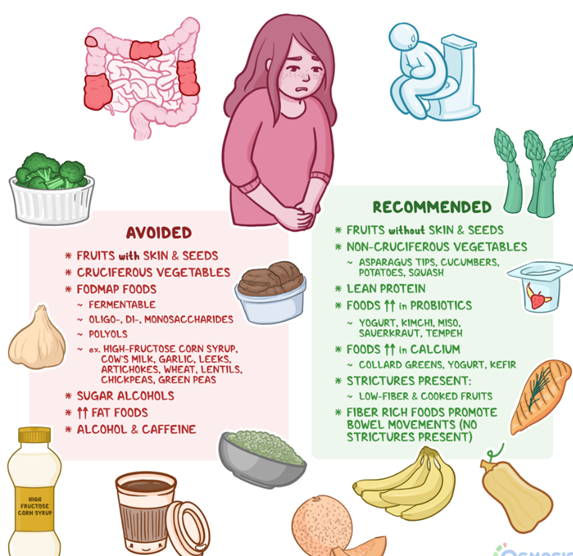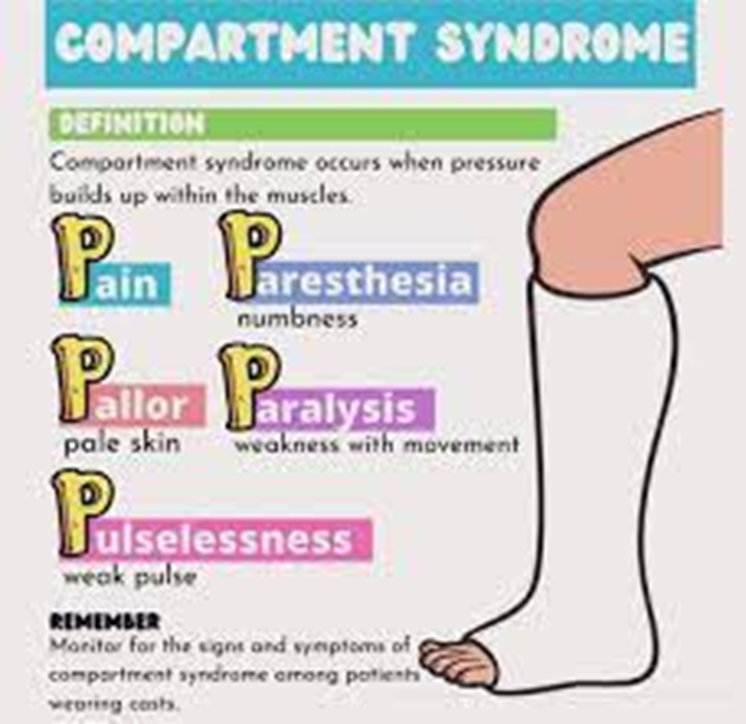A client with newly diagnosed Crohn's disease asks the nurse about dietary restrictions. How should the nurse respond?
Instruct the client to avoid foods with gluten, such as wheat bread.
Explain that the need to restrict fluids is the primary limitation.
Advise the client to limit foods that are high in calcium and iron.
Describe the use of an elimination diet to find trigger foods
The Correct Answer is D
A. Instruct the client to avoid foods with gluten, such as wheat bread.
While some individuals with Crohn's disease may experience improvement by avoiding certain types of carbohydrates, including gluten, this recommendation is not universally applicable to all individuals with Crohn's disease. Gluten restriction is more relevant for those with gluten sensitivity or celiac disease.
B. Explain that the need to restrict fluids is the primary limitation.
This statement is not accurate. Fluid restriction is not a primary dietary limitation for individuals with Crohn's disease. In fact, maintaining adequate hydration is generally important for overall health. Restricting fluids is not a standard dietary recommendation for managing Crohn's disease.
C. Advise the client to limit foods that are high in calcium and iron.
Limiting foods high in calcium and iron is not a standard recommendation for Crohn's disease. In fact, adequate intake of essential nutrients, including calcium and iron, is important for overall health. Limiting these nutrients could lead to nutritional deficiencies.
D. Describe the use of an elimination diet to find trigger foods.
This is the most appropriate response. Crohn's disease symptoms can vary among individuals, and identifying trigger foods through an elimination diet can help personalize dietary recommendations. By systematically eliminating and reintroducing foods, individuals can identify which specific foods may exacerbate their symptoms.

Nursing Test Bank
Naxlex Comprehensive Predictor Exams
Related Questions
Correct Answer is B
Explanation
A. Increased temperature to the lower extremity:
While increased temperature could indicate inflammation or infection, it is not as immediately concerning as impaired circulation.
B. Right foot pale with sluggish capillary refill.
This finding suggests a potential impairment in blood flow to the right foot, which could be due to complications such as compartment syndrome or impaired circulation. Compartment syndrome is a serious condition that occurs when there is increased pressure within a muscle compartment, leading to reduced blood flow. Pale color and sluggish capillary refill indicate compromised circulation and require prompt intervention to prevent further damage.
C. Circumferential edema of the right foot:
Edema is a common finding after a fracture and cast application. However, in the context of pale color and sluggish capillary refill, it may indicate increased pressure within the compartment, requiring immediate attention.
D. Complaint of throbbing right leg pain:
Pain is a common complaint after a fracture, and throbbing pain may be expected. However, the priority is to address the potential compromise in circulation indicated by the pale color and sluggish capillary refill.

Correct Answer is B
Explanation
A. Return appointments will be needed for IV medication:
This statement does not address the specific concern related to pain management in Raynaud's disease, and routine IV medication may not be the primary approach for pain relief in this condition.
B. Wearing gloves when handling cold items guards against painful spasms:
This is the correct answer. Raynaud's disease is characterized by vasospasm of small arteries, often triggered by exposure to cold or stress. Wearing gloves helps to minimize exposure to cold and can prevent painful spasms associated with Raynaud's.
C. Enrolling in a pain clinic can provide pain relief alternatives:
While pain clinics can offer various pain management strategies, the specific recommendation for Raynaud's disease involves minimizing exposure to cold and stress rather than enrolling in a pain clinic.
D. Painful areas should be rubbed gently until the pain subsides:
Rubbing painful areas may not be recommended, as it can potentially aggravate vasospasm in individuals with Raynaud's disease. The emphasis is on preventing triggers like cold exposure.
Whether you are a student looking to ace your exams or a practicing nurse seeking to enhance your expertise , our nursing education contents will empower you with the confidence and competence to make a difference in the lives of patients and become a respected leader in the healthcare field.
Visit Naxlex, invest in your future and unlock endless possibilities with our unparalleled nursing education contents today
Report Wrong Answer on the Current Question
Do you disagree with the answer? If yes, what is your expected answer? Explain.
Kindly be descriptive with the issue you are facing.
